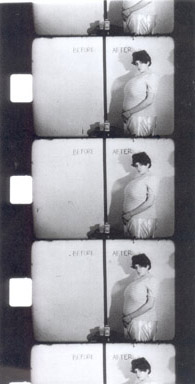Videodrome II

October 26 – December 18, 2004
The television screen is the retina of the mind’s eye. Therefore, the television screen is part of the physical structure of the brain. Therefore, whatever appears in the television screen emerges as raw experience for those who watch it. Therefore, television is reality, and reality is less than television.
David Cronenberg’s Videodrome
Videodrome II was the second incarnation at the New Museum of Contemporary Art, New York, of an exhibition of works exclusively in video. Inspired by David Cronenberg’s investigation of the integration of television into daily reality in his 1983 cult classic film Videodrome, the exhibition acknowledges video’s role as a primary medium within the production of contemporary art.
Video has a unique capacity to submerge viewers through its medium-specific characteristics, such as its reliance upon light to generate atmosphere and the requirement that it be viewed over time. Working as a collaboration, the organizers of Videodrome II viewed numerous video works before making a heterogeneous selection of some of the most challenging and innovative video of recent years. The final selection is a diverse group of artists hailing from Japan, Germany, Great Britain, the Netherlands, Los Angeles, Miami, New York, and elsewhere.
The works in Videodrome II vary widely, yet each contributes to an overall investigation of tropes addressed in video today, with particular attention paid to how technological capabilities within the medium are used by artists to underscore conceptual ideas. For example, both Christoph Girardet and Matthias Müller explore the realms of popular culture and experimental film. Appropriating imagery from Hollywood films or television, or using found footage, their work (both independently and in collaboration with one another) evokes emotional resonance, despite the absence of a linear narrative, through editing decisions and the manipulation of imagery. Euan Macdonald’s quiet focus on banal objects and activities enhances our perception of the world and elicits the poetics of the everyday. Interested in the specific uses of sound in the history of art and cinema, Jessica Bronson samples various existing soundtracks and records sounds to encourage diverse interpretation of the often sprawling visual landscapes she presents. In The Arsenal at Danzig and Other Views, Timothy Hutchings uses digital technologies to insert himself within documentary photographs of landmark buildings destroyed during the world wars and to animate this still imagery into an account of a man moving through time and space. Zilla Leutenegger references the aesthetics of video games and animation, and explores the overlap of video and drawing by merging moving images of herself within drawings of urban structures. Using the multiple points of view possible within video, Marco Brambilla takes us on a perceptual whirlwind in Wall of Death, capturing a dangerous performance in which a motorcyclist rides around a cylindrical drum. Other artists in Videodrome II include Dara Friedman, Takagi Masakatsu, Shannon Plumb, collaborators Nick Relph and Oliver Payne, Assume Vivid Astro Focus, and Erik Wesselo, among others.
Videodrome II was organized by the New Museum of Contemporary Art, New York and is made possible by the generous support of the Rockefeller Brothers Fund, the Jerome Foundation and the New York State Council on the Arts.